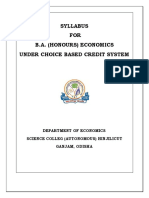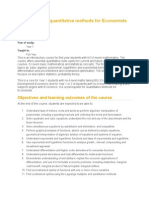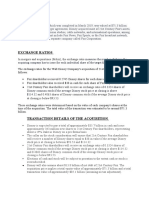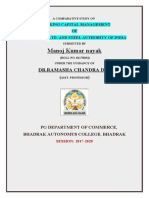BA (H) Economics
Uploaded by
hokey15009BA (H) Economics
Uploaded by
hokey15009DEPARTMENT OF ECONOMICS
CATEGORY-I
BA (HONS.) ECONOMICS
DISCIPLINE SPECIFIC CORE COURSE -4 (DSC-4): INTRODUCTORY MACROECONOMICS
CREDIT DISTRIBUTION, ELIGIBILITY AND PRE-REQUISITES OF THE
COURSE
Course title & Credits Credit distribution of the Eligibility Pre-requisite
Code course criteria of the course
Lecture Tutorial Practical/ (if any)
Practice
Introductory 4 3 1 0 Class XII NIL
Macroeconomics pass
ECON004
Learning Objectives
The Learning Objectives of this course are as follows:
• To introduce students to the basic concepts of macroeconomics
• To discuss the preliminary concepts associated with the determination and measurement
of aggregate macroeconomic variables like GDP, savings, investment, money, inflation,
unemployment and the balance of payments
• To introduce the simple analytical frame- work (e.g., the IS-LM model) for analysing the
relationships among key macroeconomic variables
Learning outcomes
The Learning Outcomes of this course are as follows:
• The students would be able to familarise the broad macroeconomic concepts like GDP,
inflation, money supply, interest rate and their inter-linkages and their interrelation-
ships.
• By studying the course, the students will able to critically evaluate various
macroeconomic policies and their effects on output and interest rate in the economy.
SYLLABUS OF DSC-4
UNIT – I: Introduction to Macroeconomic issues and National Income Accounting (12 Hours)
Basic issues studied in macroeconomics; measurements of gross domestic product, income,
expenditure and the circular flow; real versus nominal GDP; price indices; national income
accounting for open economy, balance of payments accounts; cur- rent, capital and financial
accounts.
UNIT – II: Money (10 Hours)
Functions of money; quantity theory of money; demand for money; determination of money
supply and demand; credit creation; tools of monetary policy.
UNIT – III: Simple Theory of Income Determination (11 Hours)
66 | P a g e
RnB Mentorship Hub
Classical and Keynesian systems; simple Keynesian model of income determination
UNIT – IV: IS-LM Analysis and Aggregate Demand (12 Hours)
Derivations of the IS and LM curves; fiscal and monetary multipliers; derivation of aggregate
demand
Practical component (if any) - NIL
Essential/recommended readings:
– Andrew Abel, Ben Bernanke and Dean Croushore (2011). Macroeconomics (7th
edition), Pearson.
– Richard T. Froyen (2013). Macroeconomics: Theories and Policies (10th ed.),
Pearson.
– Blanchard, O. (2006). Macroeconomics (6th edition). Pearson
– Blanchard, O. (2017). Macroeconomics (7th edition). Pearson
– Dornbusch, R., S. Fischer and R. Startz. Macroeconomics (6th edition). McGraw- Hill
– Dornbusch, R., S. Fischer and R. Startz. Macroeconomics (11th edition). McGraw-
Hill
Note: Examination scheme and mode shall be as prescribed by the Examination Branch,
University of Delhi, from time to time.
DISCIPLINE SPECIFIC CORE COURSE – 5 (DSC-5): INTERMEDIATE MATHEMATICAL
METHODS FOR ECONOMICS
CREDIT DISTRIBUTION, ELIGIBILITY AND PREREQUISITES OF THE COURSE
Course title & Credits Credit distribution of the Eligibility Pre-
Code course criteria requisite of
Lecture Tutorial Practical/ the course
Practice (if any)
Intermediate 4 3 1 0 Class XII NIL
Mathematical pass with
Methods for Mathematics
Economics
ECON005
Learning Objectives
The Learning Objectives of this course are as follows:
• To transmit the body of basic mathematics that enables the study of economic theory at
the undergraduate level, specifically the courses on microeconomic theory,
macroeconomic theory, statistics and econometrics set out in this syllabus
• Particular economic models are not the ends, but the means for illustrating the method of
applying mathematical techniques to economic theory in general
• The sophistication would be maintained at a standard level to grow in the profession
Learning outcomes
The Learning Outcomes of this course are as follows:
67 | P a g e
RnB Mentorship Hub
• The course builds the mathematical foundations necessary for further study of a variety of
disciplines including postgraduate economics, statistics, computer science, finance and
data analytics
• The analytical tools introduced in this course have applications wherever optimization
techniques are used in business decision-making for managers and entrepreneurs alike
• These tools are necessary for anyone seeking employment as an analyst in the corporate
world.
SYLLABUS OF DSC- 5
UNIT –I: Linear Algebra (15 Hours)
Vector spaces: algebraic and geometric properties, scalar product, norm, orthogonality; linear
transformations: properties, matrix representation and elementary operations; systems of linear
equations: properties of their solution sets; determinants: characterization, properties and
applications; eigenvalues and eigenvectors, diagonalization, spectral theorem.
UNIT – II: Functions of several real variables (15 Hours)
Geometric representation: graphs and level curves; differentiable functions: characterisation,
properties with respect to various operations and applications; second order derivatives:
properties and applications; the implicit function theorem, application to comparative statics;
homogeneous and homothetic functions: characterisation, applications.
UNIT – III: Multivariate optimization (15 Hours)
Convex sets; geometric properties of functions: convex functions, their characterisation,
properties and applications; quasi convex functions, their characterisation, properties and
applications; unconstrained optimisation: geometric characterisation, characterisation using
calculus, applications.
Essential/recommended readings
- Sydsaeter, K., Hammond, P. (2002). Mathematics for economic analysis, Pearson
Educational.
- Hoy, M., Livernois, J., McKenna, C., Rees, R., Stengos, T. (2001). Mathematics for
Economics, Prentice-Hall India.
Note: Examination scheme and mode shall be as prescribed by the Examination Branch,
University of Delhi, from time to time.
DISCIPLINE SPECIFIC CORE COURSE– 6 (DSC-6): INTERMEDIATE STATISTICS FOR
ECONOMICS
CREDIT DISTRIBUTION, ELIGIBILITY AND PRE-REQUISITES OF THE
COURSE
Course title Credits Credit distribution of the course Eligibility Pre-requisite of
& Code Lecture Tutorial Practical/ criteria the course (if
Practice any)
Intermediate 4 3 1 0 Class XII NIL
Statistics for pass with
68 | P a g e
RnB Mentorship Hub
Economics Mathematics
ECON006
Learning Objectives
The Learning Objectives of this course are as follows:
• This course focuses on techniques for statistical inference. The main objective of the
course is to help students understand how to draw inference from samples regarding the
underlying populations using point estimation, interval estimation and hypothesis testing.
Learning outcomes
The Learning Outcomes of this course are as follows:
• An important learning outcome of the course will be the capacity to use and analyse
statistics in everyday life. The course will improve students’ ability to analyse data,
make decisions, form predictions, and conduct research.
SYLLABUS OF DSC-6
UNIT - 1: Sampling distribution of a Statistic (12 Hours)
Concept of Statistic and parameter, Sampling distributions, Central Limit Theorem.
UNIT - 2: Estimation (12 Hours)
Estimator and methods of estimation, Point Estimation: method of moments and method of
maximum likelihood; Interval Estimation, Properties of an estimator: Consistency,
Unbiasedness, Efficiency and Sufficiency, confidence level and sample size, intervals based on
Z-distribution, t-distribution and chi-squared distribution, F-distribution.
UNIT – 3: Inference (9 Hours)
Meaning of a statistical hypothesis, errors in hypothesis testing: Type 1 and Type 2 errors,
power of a test.
UNIT - 4: Hypothesis Testing (12 Hours)
Testing of a population Mean, proportions - small and large sample tests, P-value; Testing for
variance; Testing hypothesis for two samples, testing for equality of means; testing for ratio of
variances.
Practical component (if any) - NIL
Essential/recommended readings
- Devore, J. (2012). Probability and statistics for engineers, 8th ed. Cengage Learning.
- John A. Rice (2007). Mathematical Statistics and Data Analysis, 3rd ed. Thomson
Brooks/Cole
- Larsen, R., Marx, M. (2011). An introduction to mathematical statistics and its
applications. Prentice Hall.
- Miller, I., Miller, M. (2017). J. Freund’s mathematical statistics with applications, 8th ed.
Pearson.
- Demetri Kantarelis, D. and Malcolm O. Asadoorian, M. O. (2009). Essentials of
69 | P a g e
RnB Mentorship Hub
You might also like
- I. Economics Four Year Course StructureNo ratings yetI. Economics Four Year Course Structure25 pages
- Revised BMS III SEM Common Syllabi TemplateNo ratings yetRevised BMS III SEM Common Syllabi Template41 pages
- Birla Institute of Technology and Science, Pilani: Pilani Campus AUGS/ AGSR DivisionNo ratings yetBirla Institute of Technology and Science, Pilani: Pilani Campus AUGS/ AGSR Division4 pages
- Syllabus FOR B.A. (Honours) Economics Under Choice Based Credit SystemNo ratings yetSyllabus FOR B.A. (Honours) Economics Under Choice Based Credit System24 pages
- Major Paper-1-ECO-Basic Mathematics for Economic AnalysisNo ratings yetMajor Paper-1-ECO-Basic Mathematics for Economic Analysis2 pages
- Economics _ Statistical Methods for EconomicsNo ratings yetEconomics _ Statistical Methods for Economics1 page
- ECON 2205 Introduction To Mathematical Methods in EconomicsNo ratings yetECON 2205 Introduction To Mathematical Methods in Economics2 pages
- FULL MARKS CLASSES_02012025-Nep-Comm-syllabus_revised on 02.01.25!2!35 (1).PDFNo ratings yetFULL MARKS CLASSES_02012025-Nep-Comm-syllabus_revised on 02.01.25!2!35 (1).PDF32 pages
- Introduction To Quantitative Methods For EconomistsNo ratings yetIntroduction To Quantitative Methods For Economists8 pages
- Invoice: Email Info@greensoul - Online Website Greensoul - OnlineNo ratings yetInvoice: Email Info@greensoul - Online Website Greensoul - Online1 page
- B.R. No. 197 S. 2021 - Modernizing and Refurbishing of The Financial Thresholds For Categorization PurposesNo ratings yetB.R. No. 197 S. 2021 - Modernizing and Refurbishing of The Financial Thresholds For Categorization Purposes2 pages
- Global Financial Stability Report, October 2024No ratings yetGlobal Financial Stability Report, October 2024128 pages
- DFS Aviation Services ATMInsight Flight Procedure Design 1687593951No ratings yetDFS Aviation Services ATMInsight Flight Procedure Design 16875939519 pages
- 3) A 20 Year Mortgage Set Up For Uniform Monthly Payments With 6 Percent Interest Compounded MonthlyNo ratings yet3) A 20 Year Mortgage Set Up For Uniform Monthly Payments With 6 Percent Interest Compounded Monthly4 pages
- Numerical Aptitude Questions And Answers For SSC MTSNo ratings yetNumerical Aptitude Questions And Answers For SSC MTS11 pages
- 13 Trains From Bangalore Yesvantpur Junction/YPR To Hyderabad Kacheguda/KCGNo ratings yet13 Trains From Bangalore Yesvantpur Junction/YPR To Hyderabad Kacheguda/KCG8 pages
- Revolut-RON-Statement-1 Nov 2020 To 3 Dec 2020 PDFNo ratings yetRevolut-RON-Statement-1 Nov 2020 To 3 Dec 2020 PDF2 pages
- Theory of Firm Under Perfect CompetitionNo ratings yetTheory of Firm Under Perfect Competition19 pages
- (Invoice) Renovasi MASIMA Marketing Solutions PDFNo ratings yet(Invoice) Renovasi MASIMA Marketing Solutions PDF1 page
- MY Project - WCM of Tata Steel LTD and SAIL50% (2)MY Project - WCM of Tata Steel LTD and SAIL22 pages
- Mechanical Lift Categorization: Risk Questions Yes NoNo ratings yetMechanical Lift Categorization: Risk Questions Yes No1 page
- NSS Economics (Book 3) Chapter 16 (Efficiency and Government Intervention)No ratings yetNSS Economics (Book 3) Chapter 16 (Efficiency and Government Intervention)16 pages
- Chemical Pulse Sector Update Centrum 01102024No ratings yetChemical Pulse Sector Update Centrum 0110202441 pages
- SCF-Building A Diversified Crypto PortfolioNo ratings yetSCF-Building A Diversified Crypto Portfolio23 pages
- Module 1 Monetary System and Financial System OverviewNo ratings yetModule 1 Monetary System and Financial System Overview4 pages
- Brochure - Shriram Life Super Income Plan V03No ratings yetBrochure - Shriram Life Super Income Plan V0312 pages
- Birla Institute of Technology and Science, Pilani: Pilani Campus AUGS/ AGSR DivisionBirla Institute of Technology and Science, Pilani: Pilani Campus AUGS/ AGSR Division
- Syllabus FOR B.A. (Honours) Economics Under Choice Based Credit SystemSyllabus FOR B.A. (Honours) Economics Under Choice Based Credit System
- Major Paper-1-ECO-Basic Mathematics for Economic AnalysisMajor Paper-1-ECO-Basic Mathematics for Economic Analysis
- ECON 2205 Introduction To Mathematical Methods in EconomicsECON 2205 Introduction To Mathematical Methods in Economics
- FULL MARKS CLASSES_02012025-Nep-Comm-syllabus_revised on 02.01.25!2!35 (1).PDFFULL MARKS CLASSES_02012025-Nep-Comm-syllabus_revised on 02.01.25!2!35 (1).PDF
- Introduction To Quantitative Methods For EconomistsIntroduction To Quantitative Methods For Economists
- Invoice: Email Info@greensoul - Online Website Greensoul - OnlineInvoice: Email Info@greensoul - Online Website Greensoul - Online
- B.R. No. 197 S. 2021 - Modernizing and Refurbishing of The Financial Thresholds For Categorization PurposesB.R. No. 197 S. 2021 - Modernizing and Refurbishing of The Financial Thresholds For Categorization Purposes
- DFS Aviation Services ATMInsight Flight Procedure Design 1687593951DFS Aviation Services ATMInsight Flight Procedure Design 1687593951
- 3) A 20 Year Mortgage Set Up For Uniform Monthly Payments With 6 Percent Interest Compounded Monthly3) A 20 Year Mortgage Set Up For Uniform Monthly Payments With 6 Percent Interest Compounded Monthly
- Numerical Aptitude Questions And Answers For SSC MTSNumerical Aptitude Questions And Answers For SSC MTS
- 13 Trains From Bangalore Yesvantpur Junction/YPR To Hyderabad Kacheguda/KCG13 Trains From Bangalore Yesvantpur Junction/YPR To Hyderabad Kacheguda/KCG
- Revolut-RON-Statement-1 Nov 2020 To 3 Dec 2020 PDFRevolut-RON-Statement-1 Nov 2020 To 3 Dec 2020 PDF
- Mechanical Lift Categorization: Risk Questions Yes NoMechanical Lift Categorization: Risk Questions Yes No
- NSS Economics (Book 3) Chapter 16 (Efficiency and Government Intervention)NSS Economics (Book 3) Chapter 16 (Efficiency and Government Intervention)
- Module 1 Monetary System and Financial System OverviewModule 1 Monetary System and Financial System Overview

























































































